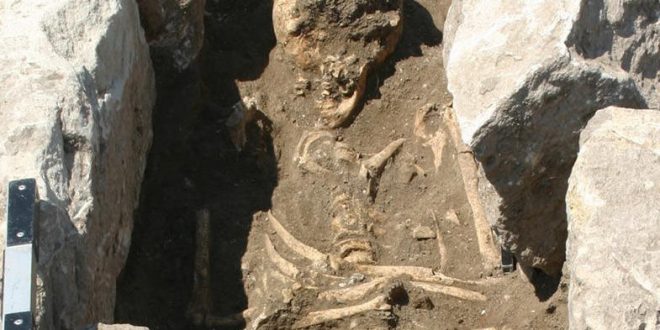A skeleton from the outskirts of what was once the ancient city of Troy, has yielded the genome of an 800 year old mystery infection.
Scientists at McMaster’s Ancient DNA Centre and the University of Wisconsin-Madison have sequenced the complete genomes of two forms of bacteria found in tissue samples dating back to the 13th century. They were collected from a woman, thought to have been about 30-years-old and likely pregnant when she died.
The samples yielded enough DNA to fully reconstruct the genomes of Staphylococcus saprophyticus, a common bacterial pathogen that causes urinary tract infections, and Garnerella vaginalis, found in modern pregnancy-related infections.
“Finding a case of maternal sepsis in the fossil record is unique,” says evolutionary geneticist Hendrik Poinar, director of the Ancient DNA Centre and a principal investigator at the Michael G. DeGroote Institute for Infectious Disease Research.
“There are no records for this anywhere,” he says. “We have almost no evidence from the archeological record of what maternal health and death was like, until now.”
The findings are remarkable because the tissue was so well preserved over so many centuries. Calcification, which likely formed as a result of the infection, created a protective mineralized layer, explain researchers.
“Calcification made little tiny suitcases of DNA and transported it across an 800-year timespan,” says Caitlin Pepperell, a University of Wisconsin-Madison expert on the evolution of pathogens and professor of medicine and microbiology.
Two mineralized ‘nodules’ found just below the ribs, likely formed while the woman was still alive, encasing the bacterial pathogens and preserving their genetic material.
“In this case, the amount and integrity of ancient DNA was extraordinary,” says Pepperell.
“Typically when we study ancient pathogen DNA in human remains (almost always bones or teeth), we are really searching for a ‘needle in a haystack’, because the bacteria represent a tiny fraction of the total DNA. In this case, half of the nodules’ DNA came just from the Staphylococcus and Gardnerella bacteria,”says Alison Devault a former graduate student in the Ancient DNA Centre.
Some of the human DNA in the nodules came from a male, suggesting that the woman was indeed pregnant with a boy. Researchers believe the cause of her death was a bacterial infection of the placenta, amniotic fluid and membranes surrounding the fetus.
Through further analysis, researchers learned one species of bacteria –Gardnerella vaginalis –was much the same 800 years ago as it is now. Genetic diversity in the species has been very well preserved, likely as a result of frequent DNA exchange among bacteria, they say.
The strain of S. saprophyticus, the second species of bacterium, appeared much different from the bacteria that infects humans in the modern world.
“The ancient strain appears more closely related to bovine strains,” explains Pepperell. “We speculate that the lifestyle of peasants in Byzantine Troy, who typically shared households with their livestock, enabled the circulation of bacteria that moved easily among humans, animals and the environment.”
Agencies/Canadajournal
 Canada Journal – News of the World Articles and videos to bring you the biggest Canadian news stories from across the country every day
Canada Journal – News of the World Articles and videos to bring you the biggest Canadian news stories from across the country every day



